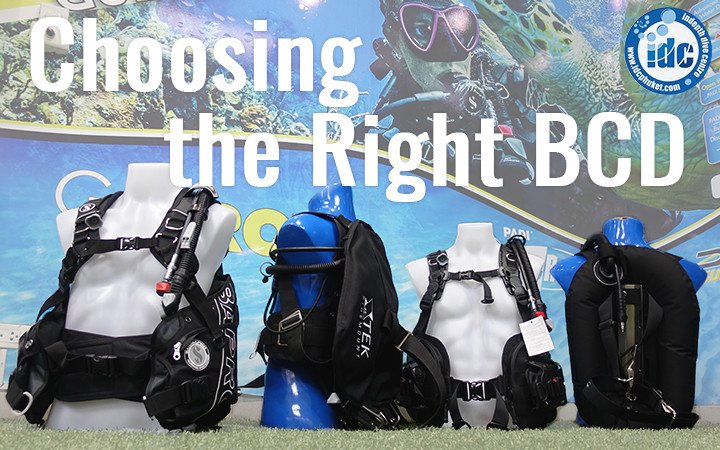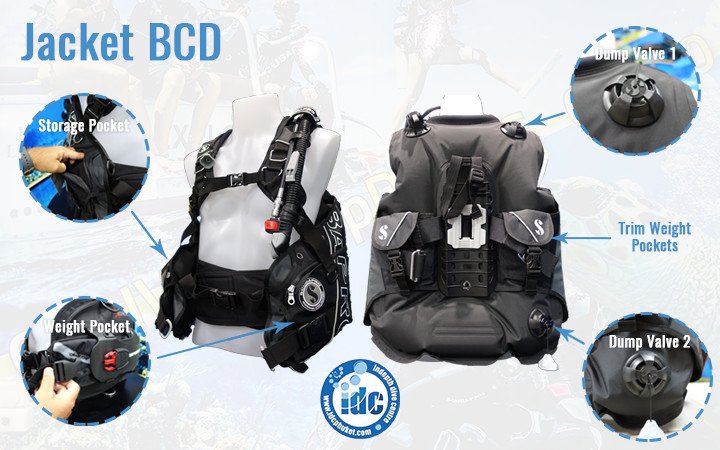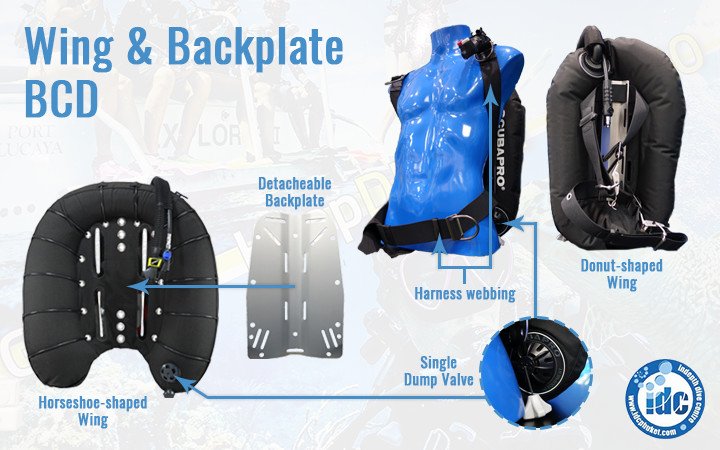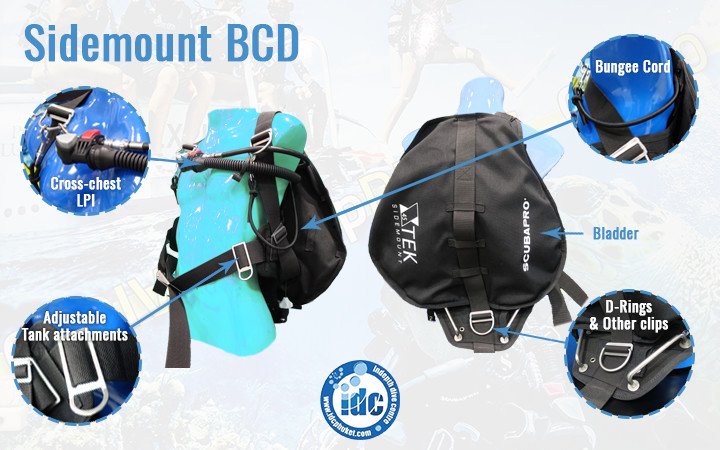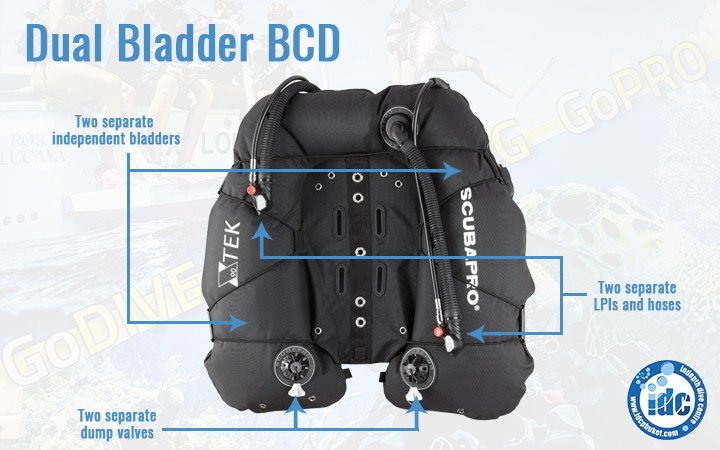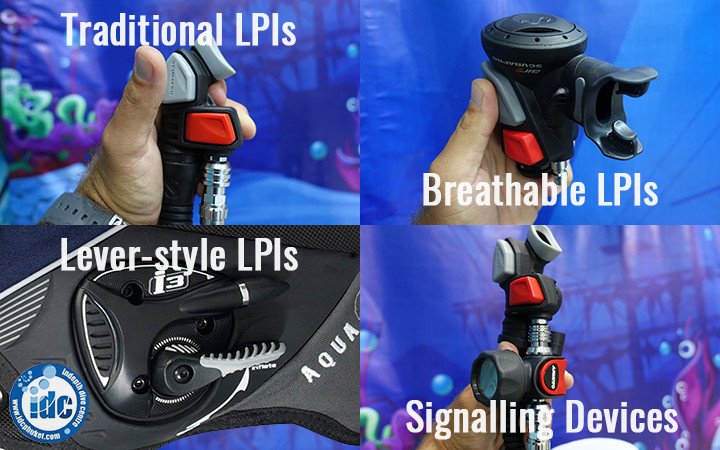Buoyancy Control Devices & Low-Pressure Inflators
A buoyancy control device (BCD) and a low-pressure inflator (LPI) by which you inflate your BCD are standard scuba equipment. In this guide, you will find everything you need to know to choose the right BCD. Although with proper training and in limited emergency situations you can manage to end your dive safely with a malfunctioning BCD and/or LPI, you cannot begin your dive without them, they are critical pieces of scuba equipment. The humble BCD was first available to recreational divers in 1970. Prior to this, divers had to control their buoyancy entirely with breath control. On the surface, they had to constantly swim to maintain positive buoyancy. Fortunately, for today’s divers, thanks to our equipment we don’t have to work so hard. Technology allowed for advancements in design & comfort, so there are now different styles of BCDs available for every type of diving.
Purpose of a BCD and considerations
On your Open Water Diver Course you learnt your Buoyancy Control Device is the central piece of equipment. It holds together your tank(s), your regulator(s), sometimes your weights and attaches them to you, the diver. Your LPI attaches to both your tank, via the first stage regulator, and to your BCD. You will use the LPI to inflate the BCD with gas from the tank to counter the weight of you and your diving equipment. Your LPI and BCD help you achieve neutral buoyancy on the dive, and to establish positive buoyancy on the surface.
How to choose the right BCD? With any piece of scuba equipment, the most important considerations are comfort and fit. A BCD which is too big for you may make buoyancy control a challenge. Likewise, a BCD that is too small or not fit for purpose may not have enough lift capacity for you and your equipment which may be dangerous. As with any equipment purchase you need to first consider what type of diving you will be doing and what you intend to use your equipment for, to ensure you purchase a product which meets your needs. When investing in new equipment, it is worthwhile taking time to adjust to that equipment and to fine-tune your buoyancy, weighting and trim. An ideal and easy way to do this is by completing your Peak Performance Buoyancy Specialty Course with a PADI instructor.
In this blog, we’ll look at some different styles of BCDs and LPIs and the features of both. This is by no means exhaustive as there are hundreds of different models and brands on the market. If you have a question about any particular piece of equipment you are using or thinking about buying, contact us here.
Types of Buoyancy Control Devices
Buoyancy Control Devices, BCDs, Buoyancy Compensation Devices or Buoyancy Compensators are the primary means by which you control your buoyancy in the water. BCDs come in a range of different styles, with different features, different lift capacities and different storage options for diving accessories such as cutting devices, surface marker buoys and reels.
Jacket BCD – Choosing the right BCD
The most common style of Buoyancy Control Device, particularly for recreational and entry-level divers, is the jacket-style. Keep this in mind when choosing the right BCD for you. This BCD gets its name because it looks, and is worn, like a jacket. This is usually the simplest form of BCD. It is most easily adjusted for different sized divers, usually with quick adjusted, sliding buckle straps. The BCDs themselves usually come in standard XS, S, M, L and XL sizes as a regular jacket would.
Shape, fit and comfort
One of the features of a jacket BCD is that the BCD wraps around the diver, usually with a cummerbund. When inflated, air is not only on the diver’s back but around the diver’s sides, towards their abdomen. This style of inflation which includes a larger air bladder is ideal for newer or uncertified divers because once inflated on the surface, the air around the front of the diver’s body holds them in a more vertical position and higher in the water, without them needing to use their fins for stability. A downside of a jacket BCD is that because of the larger air bladder, it is less streamlined in the water than other BCD styles.
Pockets
Jacket BCDs often include large, Velcro or zip-up pockets, providing ample storage options for the diver. This style of Buoyancy Control Device traditionally uses a single tank band by which the BCD is attached to the tank as well as a tank keeper which fits around the neck of the tank. Some jacket BCDs offer integrated weight pockets as well as trim weight pockets on the back, alongside the tank. However, not all models offer this feature so it is common to see divers using weight belts with this style of BCD.
Dump Valves
In terms of dump valves, there are usually two on a jacket BCD. One just behind the diver’s hip which can be used whilst in a horizontal position. Another one above the diver’s right shoulder which can be used in a vertical position. This style of BCD and this arrangement of dump valves are ideal for entry-level students and for instructors who teach them because when the student is learning skills such as neutral buoyancy or hovering, the dump valve on the shoulder gives the instructor a quick and effective means of correcting any accidental over-inflation by the student and preventing uncontrolled ascents without interfering with the student’s use of the LPI. For this reason, you probably learnt to dive in a jacket BCD on your Open Water Course.
The jacket-style of Buoyancy Control Device can be very comfortable. Many of the higher range models include padding along the back of the diver’s spine for added comfort and support.
Wing and Backplate – Choosing the right BCD
Another common style of BCD is the wing and backplate. This model is more popular in technical diving however is increasingly common in recreational diving due to its versatility. A wing and backplate is a modular system which comprises of three main parts including a wing, backplate and harness.
Shape, fit and comfort
The wing often has a donut or horse-shoe shape, and when inflated provides buoyancy. The wing is fixed onto either a steel, aluminium or carbon fibre backplate. The two are attached to the diver by a harness which usually has a crotch strap between the diver’s legs to stop the BCD from sliding upwards.
This style of Buoyancy Control Device is not commonly used as rental equipment because it can take some time and effort to adjust the harness to the individual diver. Also, depending on what the backplate’s material is, the buoyancy characteristics of the BCD will be different. Steel backplates for example are much heavier than carbon fibre backplates. A diver with a steel backplate may not need to use added weights. A diver with the carbon fibre backplate may find it easier to travel with but may still need to dive with weights. The diver normally has the option to choose what backplate material they want when they purchase their BCD which is based on personal preferences.
Versatility for different configurations
Generally, the wing is detachable from the backplate and harness and can be interchanged with a larger wing to convert the BCD from a single tank set-up to one which is designed to carry a twin-set or two back-mounted tanks. The same backplate and harness is compatible with both types of wing as well as on a closed-circuit rebreather; providing the diver with flexibility. Some backplates even include holes for bungee cords by which is possible to attach sidemount cylinders.
Single tank wing and backplates normally have two cam bands which attach to the tank. This provides more security than what a jacket BCD does by usually only having the one cam band. Wing and backplate BCDs also do not come with tank keepers to slip around the tank’s neck as a jacket BCD does. When a wing and backplate BCD is converted for twin tanks, it attaches to the tanks with bolts and wingnuts, which is incredibly secure whilst also simple to assemble and disassemble.
Advantages
When this style of Buoyancy Control Device is inflated, all the air is behind the diver and around the tank(s). This style of BCD is much more streamlined in the water. It’s easier for the diver to achieve perfect trim because the BCD itself is putting the diver into that position. Another advantage of this style of BCD is that there is no air around the diver’s sides or abdomen meaning you have more stability in the water and the front of the diver is less cluttered. With a jacket-style BCD by comparison, divers may feel like they are rolling in the water as the air moves around the jacket.
Disadvantages
On the surface, a wing and backplate BCD doesn’t hold the diver as high out of the water, or in a vertical position like a jacket BCD does which means the diver needs to use their fins to control their position. For this reason, experienced divers usually prefer this style of BCD, while it’s not always suitable for student divers.
When choosing the right BCD for you, note that a disadvantage of a wing & backplate BCD is that there are no pockets. On some models, there may be small weight pockets integrated into the harness but there is nowhere to store larger items. This style of BCD usually compensates for the lack of pockets by including additional D rings where divers can clip items such as reels and surface marker buoys. Due to the crotch strap, it is impractical for divers who need to wear a lot of weights to wear them under the harness as they will be unable to drop their weights in an emergency. For this reason, some models have the crotch strap removed to modify the BCD for use with a weight belt.
Dump Valves
A wing BCD usually has one dump valve just below the diver’s hip, used only in a horizontal position. Differently, a jacket BCD almost always has two; one on the hip and the other on the shoulder.
Sidemount – Choosing the right BCD
The design of a sidemount BCD allows to carry two or more tanks, but on the sides of the diver and not on their back.
Features
This type of BCD generally has a bigger air bladder to counter the weights of multiple tanks but is often integrated, or attached to a harness. On other models, the air bladder may be detachable from the harness. Sidemount BCDs can offer integrated weight options but they are normally down the diver’s spine. In case of emergency, however, it is not possible to remove or replace the weights.
The top of the BCD often has a number of little stainless-steel holes in it. These are for bungee cords which wrap around the top of the tanks and pull them into correct trim, neatly under the diver’s armpits. Sidemount divers have options for how they want to bungee their tanks, so the BCD usually comes with a bungee cord but separately to the BCD. This allows divers to configure their Buoyancy Control Device to their own preferences.
A sidemount BCD has an LPI, similar to a back-mounted BCD does but this is strapped across the diver’s chest. Unless there’s an equipment malfunction requiring the diver to unclip it, it is only used for inflation. On a sidemount BCD, the diver deflates from a dump valve on their lower back. For this reason, sidemount divers must ascend and descend in a horizontal position, occasionally facing head down to vent air. By comparison, almost all other recreational divers are trained to ascend and descend in vertical positions and hold the LPI above their heads to vent air. A sidemount LPI can be configured on either side of the diver and is entirely at the diver’s discretion. Other BCDs, by comparison, use the LPI hose for inflation and deflation and it is always on the left.
D-rings
Sidemount BCDs include multiple D-rings and more than what you would expect to see on any other type of BCD. There are normally two D-rings on the shoulders which generally divers only use on the surface or for stage tanks. The rest of them are around the diver’s hips and buttocks. This is because aluminium tanks change their buoyancy during the dive and in response to how much gas the diver breathes from them, meaning the diver needs to constantly adjust the rear position of the tank to ensure the tank stays in trim and doesn’t begin to float upwards. If you would like to read more about tanks and their buoyancy characteristics, click here.
Recreational and Technical Sidemount BCDs
Sidemount BCDs come in both recreational and technical models. The main difference is the lift capacity of the BCD, including the size of the air bladder. A technical model’s design allows to carry more weight and therefore has a bigger bladder and a bigger lift capacity than a recreational model. It is also possible to convert a sidemount BCD for use with some types of side-mounted rebreather.
Dual Bladder BCDs – Choosing the right BCD
Some BCDs, particularly those designed to be used with multiple tanks are available with dual bladders. On this style of BCD, there are two independent air bladders and two separate LPIs and hoses. The purpose of this design is redundancy. If the primary air bladder ruptures, the diver can switch to the redundant bladder and safely end the dive. This style of BCD is more common in technical diving and generally more expensive. A dual bladder, however, is not entirely necessary as other, more affordable redundant buoyancy devices. Equipment such as dry suits, surface marker buoys and lift bags can operate as BCD in an emergency. This goes beyond recreational diving though, so for any equipment you use, it is important for your own safety that you have the proper training to use it.
Lift capacity – Choosing a Buoyancy Control Device
The last consideration in choosing the right BCD for you is the lift capacity of the BCD itself. Lift capacity refers to how much negative weight the BCD can lift and hold. The reason this is important is you need your BCD to be capable of maintaining neutral buoyancy at the depths you plan to dive, and to counter the water pressure at those depths. Your BCD also needs to be capable of lifting you, your weights, your equipment and in the event of an emergency or rescue situation, a second diver. If you have done your Rescue Diver Course, you will recall the exercise where you used one LPI and BCD, either yours or your buddy’s, to lift your unresponsive buddy from the bottom and safely bring them to the surface. You likely did this exercise twice using your BCD for one rescue and your buddy’s on another.
Furthermore, your BCD also needs to be able to hold you and all your equipment positively buoyant on the surface. If you are a bigger person or are diving with multiple tanks and beyond recreational depths, you will need a greater lift capacity than a smaller diver who is only diving with a single tank within the recreational limits. BCD manufacturers state the lift capacities of their BCD in the user manual. But to choose the right BCD for you, you need to know what kind of diving you want to do. Then a dive centre can easily point you in the direction of a BCD which will not only fit you but which has the appropriate lift capacity for the diving you plan to do. This is the advantage of buying equipment in person, from dive professionals, rather than trying to purchase items online.
Low-Pressure Inflator (LPI) styles
Your Low-Pressure Inflator or LPI attaches to your first stage regulator as well as to your Buoyancy Control Device. When you press the inflate button/lever, gas from the tank will inflate your BCD to increase your buoyancy. Although most divers learn to dive with a traditional LPI set up where the LPI sits over your left shoulder, there are now other models and styles available:
Traditional LPIs
Most LPI and BCD designs allow for the LPI to hang over the diver’s left-hand shoulder. This design allows the diver to add air to the BCD from any position. But in order to vent air from the Buoyancy Control Device, the diver needs to move to a vertical position in the water and hold the LPI above their heads to allow the air to escape. This is the most common style of LPI which most divers learn to use on their Open Water Course.
Breathable LPIs
Some models of LPI include a second stage regulator on them. This allows the diver is able to breathe from their LPI in the event their buddy is out of air. They can then donate their primary regulator to the out of air diver. When the diver is breathing from the LPI however, it can make it difficult to vent air from the BCD using the LPI hose. In this case the diver may rely on the dump valve instead. Some divers opt to use a standard alternate air source and use their breathable LPI as a last resort. This means they basically carry three second stage regulators on their dives…talk about redundancy!
Lever-style LPIs – Modern Buoyancy Control Devices
A modern and popular feature of many BCDs now is the level style mechanism of LPI. Instead of the LPI hose hanging over the diver’s shoulder, the LPI is connected to the rear, left of the diver’s BCD behind the diver’s hip, and is operated by a lever. To add and vent air, the user pushes the lever up or down. This mechanism operates from any position, it doesn’t require the diver to move into a vertical position. Many divers find this style a convenient and easy model to use. The diver still maintains an LPI hose on their BCD, which allows oral inflation in case of emergency.
Audible Signalling Devices
Another popular attachment to the standard LPI is an audible signalling device. It connects to the LPI and uses a small amount of gas from your tank to make a sound. On the surface, this device works like an air horn but can also be used underwater to get attention. Funnily, it makes a sound similar to a duck, hence the nickname “duck quacker”.
As with any equipment purchase, we strongly recommend you come into the shop and try on as many different types of equipment as possible to find your ideal fit. With BCDs, we also recommend you try diving in different models to get a feel for them in the water. If you would like to book some diving with us and try different equipment in the water, contact us here.We’re happy to facilitate any requests we can. This is the best way for choosing the right BCD for you
Popular BCD Manufacturers
More Indepth posts about diving equipment:
- Choosing Dive Equipment
- Choosing a Scuba Diving Mask
- All about snorkels
- Choosing the right fins
- Scuba Cylinders & Valves
- How to choose a Scuba Regulator
- Breathing Gas Monitoring Devices
- Depth Monitoring Devices
- Scuba Diving Weights & Quick Release Weight Systems
- Choosing a wetsuit for Scuba Diving
- Audible Signaling Devices for Scuba Diving
- Choosing a Scuba Diving Compass



